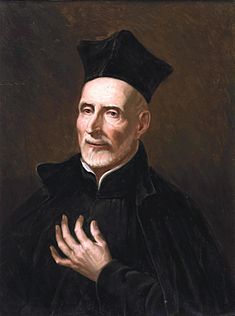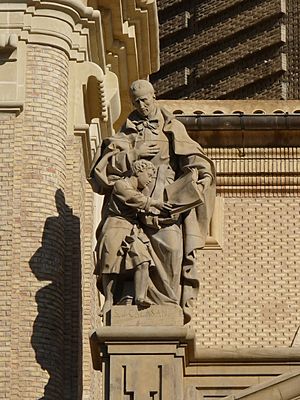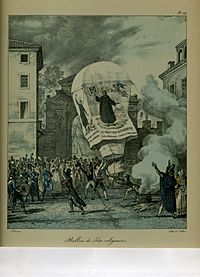Joseph Calasanz facts for kids
Quick facts for kids SaintJoseph Calasanz SchP |
|
|---|---|

Portrait by Francisco Jover y Casanova, currently held in the Museo del Prado
|
|
| Born | 11 September 1557 Peralta de la Sal, Kingdom of Aragon, Crown of Aragon |
| Died | 25 August 1648 (aged 90) Rome, Papal States |
| Venerated in | Catholic Church |
| Beatified | 7 August 1748, Rome, Papal States by Pope Benedict XIV |
| Canonized | 16 July 1767, Rome, Papal States by Pope Clement XIII |
| Major shrine | San Pantaleo, Rome |
| Feast |
|
Joseph Calasanz (born September 11, 1557 – died August 25, 1648) was a Spanish Catholic priest and teacher. He is famous for founding the Pious Schools, which offered free education to poor boys. He also started the religious order that ran these schools, known as the Piarists. Joseph Calasanz was a close friend of the famous astronomer Galileo Galilei. The Catholic Church honors him as a saint.
Contents
Early Life and Calling
Joseph Calasanz was born in 1557 near Peralta de la Sal in Spain. He was the youngest of eight children. His parents, who were minor nobles, made sure he received a good education at home and then at a local school.
When he was 12, he went to a college in Estadilla. At 14, he decided he wanted to become a priest. His parents did not support this idea at first.
Joseph studied philosophy and law at the University of Lleida. He earned a law degree with honors. Later, he studied theology at other universities.
After his mother and brother died, his father wanted him to marry. However, Joseph became very sick in 1582. After he recovered, his father finally agreed to his wish. Joseph was ordained a priest on December 17, 1583.
In Spain, Joseph held several church positions. He worked in different dioceses, helping bishops and managing church affairs. He also started a charity that gave food to the poor.
Helping Children in Rome
In 1592, when he was 35, Joseph moved to Rome. He hoped to advance his church career there. But in Rome, he saw many poor and homeless children who needed help. He felt a strong desire to teach them.
He joined a group called the Confraternity of Christian Doctrine. He started gathering boys from the streets to teach them. However, teachers didn't want to work without pay.
In 1597, a local priest offered Joseph two rooms near his church. With help from other priests, Joseph opened the first free public school in Europe on November 27, 1597. This was a big step because education was usually only for the wealthy.
In 1598, a huge flood hit Rome. Joseph helped with the rescue and recovery efforts. In 1600, he opened another "Pious School" in central Rome. Soon, many more schools were needed because so many students wanted to join.
Pope Clement VIII started giving money to support Joseph's work. Many others also helped. Soon, Joseph was teaching about 1,000 children. In 1602, he rented a house and started living with his assistants. This was the beginning of the Order of the Pious Schools, or Piarists.
In 1610, Joseph wrote down his ideas about education. These rules guided how teachers and students should act. In 1617, Pope Paul V officially approved his group. Joseph and his fourteen assistants became the first members of the new congregation. They were the first priests whose main job was teaching in elementary schools. Joseph believed that if children learned about faith and academics early, they would have happy lives.
Joseph also visited Rome's main churches and cared for the sick during plagues. He was known for his patience and strength during difficult times. He opened Pious Schools in many parts of Europe. In 1621, his congregation became a full religious order with special vows. Piarists take vows of poverty, chastity, and obedience. They also take a fourth vow to dedicate their lives to educating young people.
Revolutionary Educational Ideas
Joseph Calasanz was a pioneer in education. He founded the first free public school in modern Europe. This was a revolutionary idea because it broke down class barriers. He believed all children, rich or poor, deserved an education.
He treated all students with respect, even those from different backgrounds. He welcomed Jewish and Protestant children into his schools. He even received a request from the Ottoman Empire to set up schools there, but he didn't have enough teachers.
Joseph created a system for teaching primary school students. He also focused on physical education and hygiene. He wanted school leaders to check on children's health.
He taught students to read in both Latin and their local language. He believed in using local languages for textbooks, which was very modern for his time. He also stressed the importance of math and science.
Most importantly, Joseph wanted to give his students a strong moral and Christian education. He believed that education was the best way to improve society. He trained his teachers to be good Christian role models.
Joseph was also the first to suggest a "preventive method" for discipline. This means it's better to prevent bad behavior than to punish it. He believed in using kindness and love as the basis for discipline, rather than harsh punishments.
Friends with Great Thinkers
Joseph Calasanz understood how important math and science were for the future. He made sure these subjects were taught in his schools. He was a friend of the famous scientist Galileo Galilei. Joseph even sent some of his best Piarist teachers to study with Galileo. He supported Galileo's ideas about the universe, even when they were controversial.
When Galileo faced difficulties, Joseph told his Piarists to help him. He allowed them to continue studying with Galileo. Even when people criticized the Piarists for supporting Galileo, Joseph stood by him. When Galileo lost his eyesight in 1637, Joseph arranged for a Piarist to be his secretary.
Joseph also had a strong friendship with the philosopher Tommaso Campanella. Campanella had many new ideas about society and education. Joseph invited him to teach philosophy to his teachers. Campanella also defended Joseph when he faced challenges.
Challenges and Legacy
Joseph's ideas about free education for all, his schools for the poor, and his support for Galileo's science caused problems. Many powerful people in society and the church opposed him. In 1642, he was briefly questioned by the Inquisition.
There were also internal problems within his order. Some people caused trouble, and this led to difficulties for the Piarists. Because the Piarists were linked to Galileo, they faced opposition from other religious groups. In 1646, the Piarist Order lost some of its privileges. However, the order was restored ten years later.
Joseph Calasanz remained loyal to the Church throughout his life. He died on August 25, 1648, at the age of 90. He was admired for his holiness and courage by his students, their families, and the people of Rome. He was buried in the Church of San Pantaleo.
Honoring Saint Joseph Calasanz
Eight years after his death, the Pious Schools were fully recognized again. Joseph Calasanz was declared "blessed" on August 7, 1748. He was later made a saint on July 16, 1767.
In 1948, Pope Pius XII declared him the "Universal Patron of all Christian popular schools in the world." This means he is considered a special protector of schools for ordinary people.
His heart and tongue are preserved in a chapel in the Piarist motherhouse in Rome.
Pope John Paul II said that Saint Joseph Calasanz followed the example of Christ. He tried to teach young people not only school subjects but also the wisdom of the Gospel.
Saint Joseph Calasanz's feast day is celebrated on August 25. Many schools and churches around the world are named after him. The Piarist Order also celebrates November 27 as a special day to honor him. This date marks the day he opened his first free public school in 1597.
See also
 In Spanish: José de Calasanz para niños
In Spanish: José de Calasanz para niños
- Piarists
- Pious Workers of St. Joseph Calasanctius of the Mother of God, named after him
- Peter Fourier
- Alix Le Clerc
Sources
- Josep Domènech i Mira, Joseph Calasanz (1557–1648), "Prospects: Quarterly Review of Comparative Education. Paris, UNESCO, XXVII: 2, 327–39. [1]
- "Calendarium Ordinis Scholarum Piarum. Rome, 2018.



